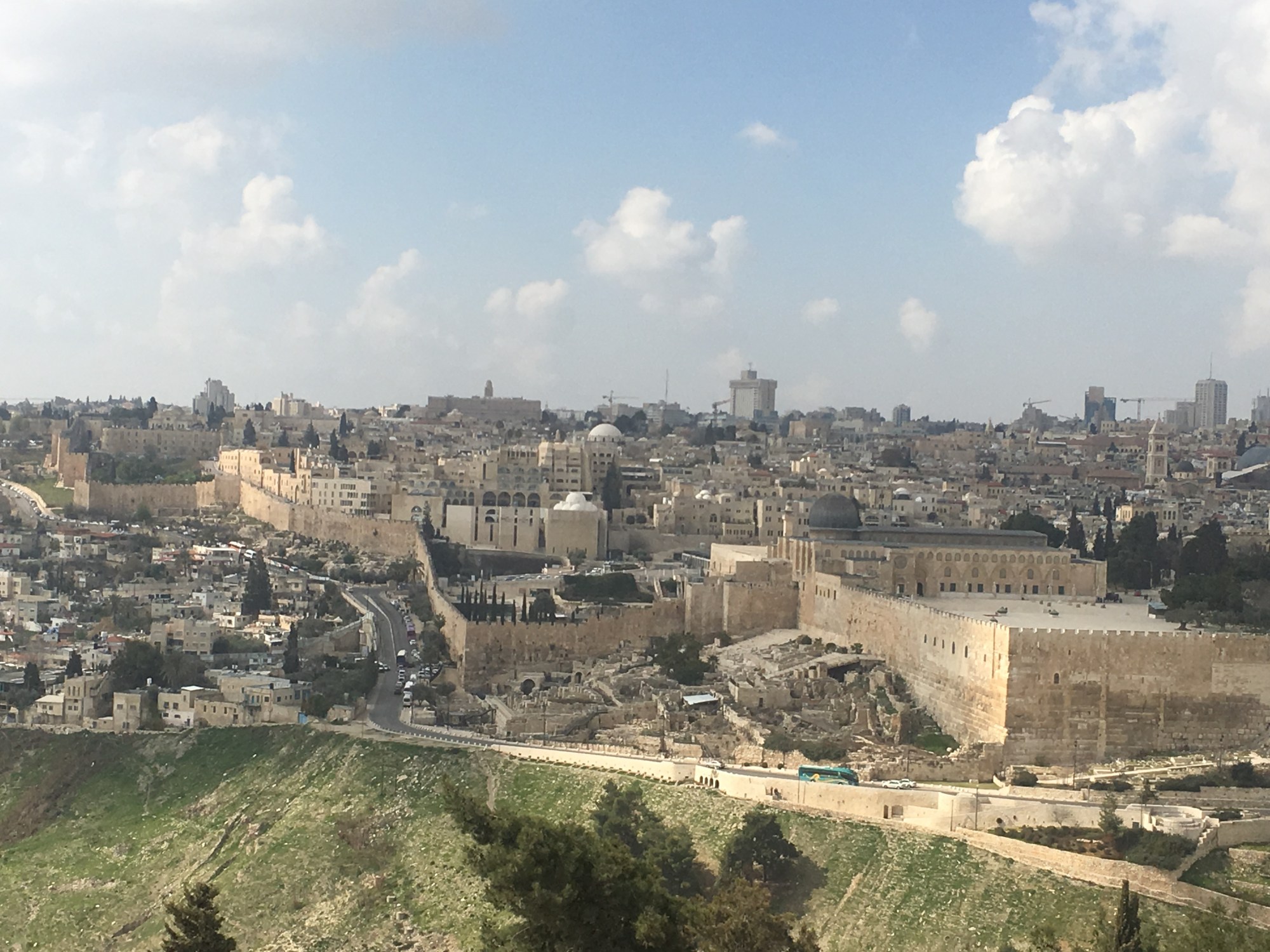On Saturday, we took a taxi to the Garden of Gethsemane. Since it was Shabbat, much of Jerusalem was still and quiet – or at least more so than normal. I’m not ever quite sure what to expect at holy sites since they have all become commercialized to some degree. I don’t mean that in a bad way. Over the centuries, followers of Christ have attempted to some form or fashion to acknowledge the places were key events took place. Some are simple, almost Spartan in appearance, while others are elaborately ornate, bordering on gaudy had the sentiment behind the expression not been so intense. Even when I know exactly where we are going, it still takes a minute to wrap my head around what I’m actually seeing.
The moment we stepped out of the taxi, we were greeted by an older gentleman with a cane and trench coat; he was a calmly confident man who introduced himself as a guide and offered to explain things to us. While it would prove to be a costly tour (and he didn’t spring the price on us until we were done – well played, Mr. Guide.), it was worth it. Whether Christ follower or not, he spoke of the Garden and its events in a venerable warmth that went far beyond some sing-songy relay of facts.
We began with a stroll around the perimeter of Garden of Gethsemane, where Jesus prayed with His disciples, and was there betrayed by Judas. The name in Hebrew means “olive press” and, indeed, olive oil is still produced from the Garden’s trees. There’s a fence around the area now, probably to protect the Garden from over-zealous pilgrims, but it somehow manages to contribute to the quiet charm of the space. I can easily imagine Jesus choosing this place to be alone with His Father on the eve of the greatest event in the history of mankind. Even today, people speak in hushed tones as they circle the Garden, respectful of its unassuming sacredness. The olive trees there are believed to be, if not original, then definitely descendants of the trees growing at that time. They are estimated to be anywhere from 1000-2000 years old. Our guide told us that olive trees never really die. At first I wanted to disagree with him, but closer inspection revealed life emerging from gnarled trunks that one might otherwise assume dead. New limbs continually spring from the old. There’s a subtle metaphor for life in their example.
In the immediate vicinity, there are several strongly contrasting church buildings, ranging from the incredibly ornate Church of All Nations (where Chinese Catholics were observing mass), to the tiny and simple Grotto run by Franciscans, to the Tomb of Mary. Here Greek Orthodox and Armenians share the space. The ceilings are stained black from the candle smoke, coming from the largest collection of chandeliers and lamps I’ve ever seen in one spot. This particular site is more symbolic because no one knows exactly where Mary was buried.
Of the three structures, I preferred the Grotto. I found the other two to be, well, ostentatious. I mean no offense to my Catholic friends in saying this. I understand people who have a great love for their Lord and want to give Him their very best, most beautiful offerings. That just isn’t my style. I prefer the unpretentious little space. This is a natural grotto, where Jesus and His disciples often camped at night, including that fateful night when they slept while He prayed. It feels real and homey to me. Like those men did so long ago, this is the kind of space I would choose to rest and pray and think.
After being offered clippings from the olive trees, which were pruned the day before, we took a crazy twisty uphill drive to the top of the Mount of Olives. Several important biblical events took place on this mountain: David fled here to escape his son Absalom, King Solomon set up pagan shrines here for the gods of his foreign wives, Ezekiel had a vision of “the glory of the Lord” stopping over the Mount, and Zechariah prophesied that the Mount of Olives is where the Lord of Hosts will stand at the final defeat of the forces of evil. Many people want to be first in line for this long-awaited event and are buried on the hillside.
The Mount of Olives would be a reasonable place for Jesus to look over the city of Jerusalem, weep over her, pray for her. This has also been my favorite view of Jerusalem. Here you can see the outside of the Western Wall and the closed Eastern Gate, where Messiah will make His triumphant return. There is something deeply spiritual about the place that is impossible to explain. Standing there, you cannot help but sense the connection between its sometimes dark and tumultuous past and its glorious future.


Beautiful!
LikeLike